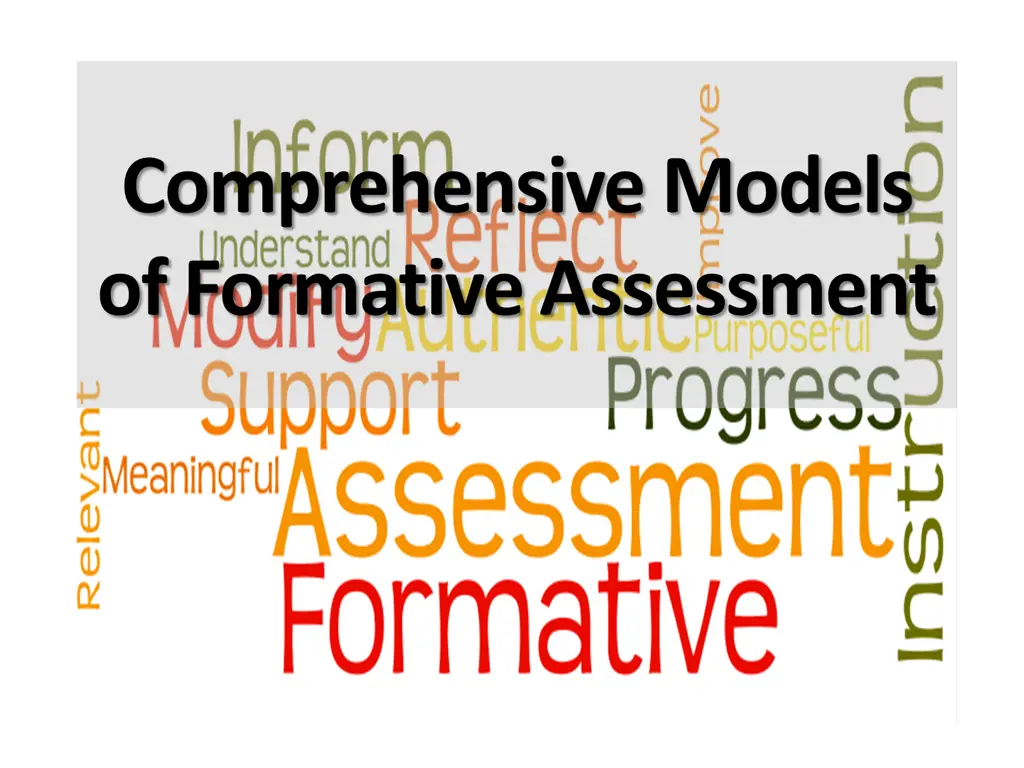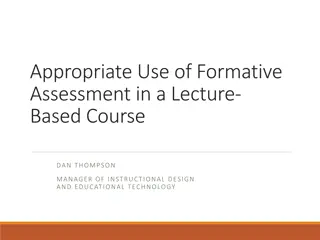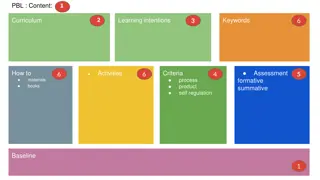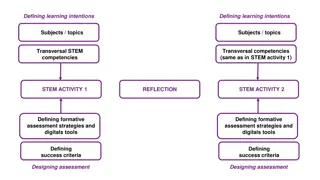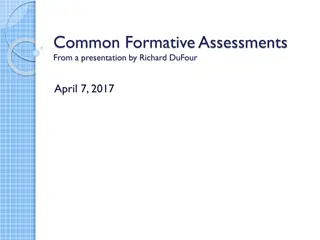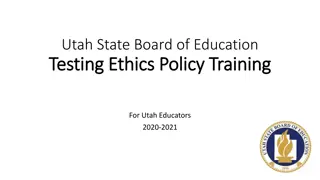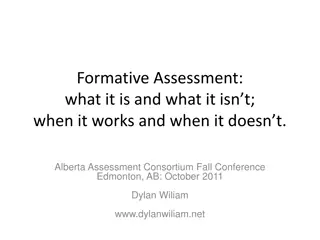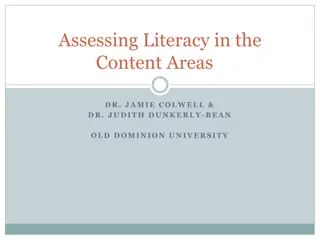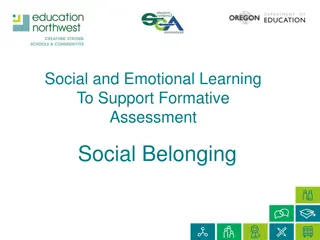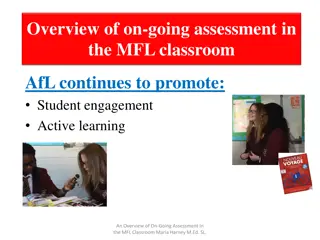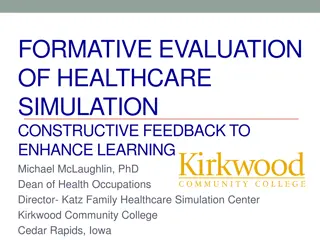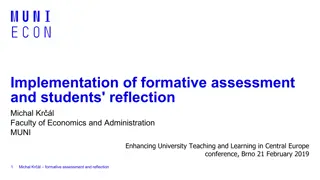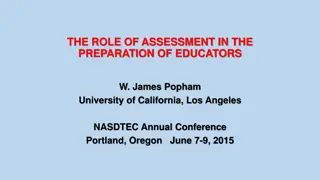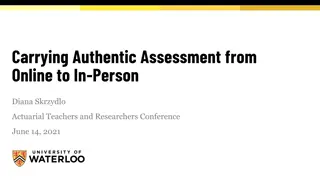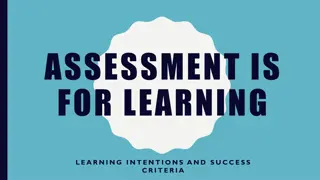Enhancing Learning with Formative Assessment Models
Explore comprehensive and theory-based models of formative assessment, such as the 7-Step Model and Tuttle's approach. Understand the importance of learning progressions to inform assessment strategies and foster student development. Discover practical techniques like pre-assessment, sharing learning goals, and providing feedback to enhance classroom learning experiences.
- Formative assessment
- Learning progressions
- Classroom strategies
- Student development
- Assessment techniques
Download Presentation

Please find below an Image/Link to download the presentation.
The content on the website is provided AS IS for your information and personal use only. It may not be sold, licensed, or shared on other websites without obtaining consent from the author. Download presentation by click this link. If you encounter any issues during the download, it is possible that the publisher has removed the file from their server.
E N D
Presentation Transcript
Comprehensive Models of Formative Assessment
7 Step Model Where am I Going? 1. Provide students with a clear and understandable vision of the learning target. 2. Use examples and models of strong and weak work. Where am I Now? 3. Offer regular descriptive feedback. 4. Teach students to self assess and set goals. How Can I Close the Gap? 5. Design lessons to focus on one learning target or aspect of quality at a time. 6. Teach students focused revision. 7. Engage students in self-reflection and let them keep track of and share their learning.
Tuttle (2009) 1) Pre-assessing students 2) Sharing learning goals with students 3) Sharing or co-creating of learning criteria with students 4) Employing quality classroom discourse and questioning 5) Using rich and challenging tasks that elicit students responses 6) Identifying the gap between where the students are now and the desired standard goal 7) Providing feedback that helps students identify how to improve 8) Using self-assessment and peer assessment 9) Providing students with opportunities to close the gap between current and desired performance 10) Celebrating learning progressions
What are Learning Progressions Learning progressions describe in words and examples what it means to move over time toward more expert understanding of some big idea or topic. depict successively more sophisticated ways of thinking about an idea that might reasonably follow one another as students learn. have been referred to by many different names, including progress variables, learning trajectories, progressions of developmental competence, and profile strands.
Learning Progressions inform Assessment Learning progressions inform assessment in the following cycle Translate the big ideas assessment tasks or activities suitable for classroom settings through which students can demonstrate their understanding of big ideas and practices. Use student performances to develop clusters of assessment tasks or items, including both traditional and nontraditional items. Use rning as a basis for rubrics to interpret student responses, explaining how responses reveal students thinking with respect to big ideas and learning progressions.
Formative Feedback Don t leave it open-ended or ambiguous. Give clear indications of the criteria that have been used to assess the quality of the product a student submits Don t wander from the point. Base all feedback on criteria specified for the assignment. Don t delay. Provide feedback as soon as possible after the student submits the assignment.
The scoring of assessments Defensible means that there are legitimate reasons for giving a mark and the system can stand up to scrutiny. Rigorous means that the system is reliable and iterative Standardized means that there is low inter- rater reliability
The scoring of assessments This might not be a problem in scoring MCs, but CRs and Open-Ended PAs can prove a problem. The most popular solution is the Rubric.
The scoring of assessments-Rubrics A scoring rubric is a set of ordered categories to which a given piece of work can be compared. Scoring rubrics specify the qualities or processes that must be exhibited in order for a performance to be assigned a particular evaluative rating.
Parts of a Rubric A scale of points representing a continuum of quality. Descriptors containing standards and criteria to judge the performance of the work. Criteria for the conditions associated with successful performance. Standards for describing how well criteria must be met
Types of Rubrics TypesPurpose/Distinction* Focal Use To provide overall evaluation guidelines that clarify how grades relate to performance/ achievement, such as in course grades To break assignments or scores down into separate components for grading (description, analysis, grammar, references, etc.) Designed to provide general guidance as to expectations, such as for grading of written assignments Provide a single score based on an overall impression of learner achievement on a task. Holistic Provide specific feedback along several dimensions Analytic GeneralContain criteria that are general across tasks Designed to provide detailed guidance regarding a specific assignment or task Task- specific are unique to a task/assignment
Table 2: Template for analytic rubrics Beginning 1 Developing 2 Accomplished 3 Exemplary 4 Criteria #1 Description reflecting beginning level of performance Description reflecting movement toward mastery level of performance Description reflecting achievement of mastery level of performance Description reflecting highest level of performanc e Criteria #2 Description reflecting beginning level of performance Description reflecting movement toward mastery level of performance Description reflecting achievement of mastery level of performance Description reflecting highest level of performanc e Criteria #3 Description reflecting beginning level of performance Description reflecting movement toward mastery level of performance Description reflecting achievement of mastery level of performance Description reflecting highest level of performanc e Criteria #4 Description reflecting beginning level of performance Description reflecting movement toward mastery level of Description reflecting achievement of mastery level of performance Description reflecting highest level of performanc e
Table 1: Template for Holistic Rubrics ScoreDescription Demonstrates complete understanding of the problem. All requirements of task are included in response. Demonstrates considerable understanding of the problem. All requirements of task are included. 5 4 Demonstrates partial understanding of the problem. Most requirements of task are included. Demonstrates little understanding of the problem. Many requirements of task are missing. Demonstrates no understanding of the problem. 3 2 1 0 No response/task not attempted.
Developing a Rubric Identify the type and purpose of the Rubric Identify Distinct Criteria to be evaluated Determine your levels of assessment Describe each level for each of the criteria, clearly differentiating between them Involve learners in development and effective use of the Rubric Pre-test and retest your rubric
Developing a Rubric Identify the type and purpose of the Rubric - Consider what you want to apply assess/evaluate and why. Identify Distinct Criteria to be evaluated - Develop/reference the existing description of the course/assignment/activity and pull your criteria directly from your objectives/expectations. Make sure that the distinction between the assessment criteria are clear.
Developing a Rubric Determine your levels of assessment - Identify your range and scoring scales. Are they linked to simple numeric base scores? Percentages? Grades? Describe each level for each of the criteria, clearly differentiating between them - For each criteria, differentiate clearly between the levels of expectation. Whether holistically or specifically, there should be no question as to where a product/performance would fall along the continuum of levels.
Developing a Rubric Involve learners in development and effective use of the Rubric - Learner engagement in the initial design and development will help to increase their knowledge of expectations and make them explicitly aware of what and how they are learning and their responsibility in the learning process.
Developing a Rubric Pre-test and retest your rubric - A valid and reliable rubric is generally developed over time. Each use with a new group of learners or a colleague provides an opportunity to tweak and enhance it.
